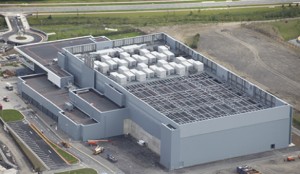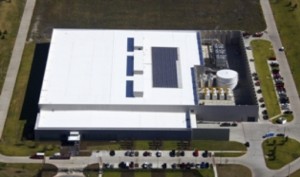As data center workloads grow we hear about new large-scale mega data centers being built. According to a recent report Microsoft is planning on building a $9 Billion data center in Korea.

This photo shows one of Microsoft’s large-scale data centers in Dublin.
(courtesy datacenterdynamics)

Cisco’s own Allen data center in Allen Texas is 38000 square feet.
You can take virtual tour of the data center.
As more of these large data centers are built, managing them efficiently will have to both from a facilities, and an IT point of view. The research firm, IDC has started tracking a category of software called DCIM or data center infrastructure management. DCIM extends the traditional data center management function to include physical assets such as buildings, compressors, fans etc. We can expect DCIM software to handle
- Capacity Planning
- Asset Lifecycle Management
- Energy efficiency
- Physical asset monitoring
- Optimal placement of assets
- Security monitoring
We should expect the software to include sensor systems, power management solutions, analytics packages, and monitoring. Mega data centers usually strive for reduction of carbon dioxide emissions and energy efficiency. DCIM solutions enable data center managers to measure energy use and improve the data center’s power usage effectiveness (PUE) and data center infrastructure efficiency. In addition to measuring energy use, other DCIM components may maximize the use of airflow and optimize use of space to further drive down infrastructure costs. The DCIM solutions may thereby allow optimal server placement with regard to power, cooling and space requirements. Temperature monitors smoke detectors and surveillance cameras may also be managed by DCIM solutions.
From an IT point of view, a mega data center could house thousands of servers. The only way to manage such large numbers of servers is with policy-based automation. Data center managers may choose to write custom software, or use vendor tools to help with this formidable task. Mega data centers will not have identical servers, and they will have to be treated in a multitude of ways. There are several reasons for this.
- Some servers maybe for production while the others may be for test / development / backup etc and of lower importance.
- The servers maybe in use for different customers (tenants) who may need to run different workloads.
- Compliance requirements for a workload may demand certain special needs with regards to network isolation and access.
Given the diverse needs and requirements for large scale data centers, the management tools muse be:
- Resilient: Be highly available to ensure business resilience and rapid recovery from disasters.
- Scalable: Capable of robust scaling to meet the dramatic increase in data and processing.
- Secure: Provide the visibility and transparency of policies at the physical and virtual machine levels.
- Open: Offer real choice, including third-party technology, integration, and standards.
Cisco UCS is a fabric-based infrastructure ideally suited for large-scale data centers running a variety of workloads. For managing the Cisco UCS in a large-scale environment with the demands of mega data centers, we have the Cisco UCS Central. An individual domain with the UCS Manager can have upto 160 managed servers. UCS Central is designed for multiple UCS domains.
- UCS Central is built on UCS Manager technology to manage thousands of servers
- It provides the foundation for efficient global administration, high availability and workload mobility
- UCS Central simplifies global operations of UCS infrastructure with centralized firmware upgrades, inventory, faults, logs and server consoles
- It centralizes setup of global policies, service profiles, ID pools and templates without becoming the single point of failure
- Data center managers can now harness global human capital with it
- It exposes an open XMI API for large scale automation, and integration with other data center management tools
- It provides a centralized fault summary for faster problem resolution and better reliability
To find out more about Cisco UCS Central join the google hangout on March 11 at 8 AM Pacific.
CONNECT WITH US